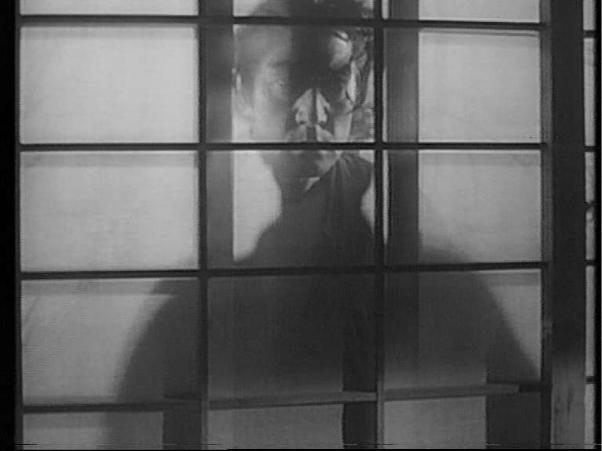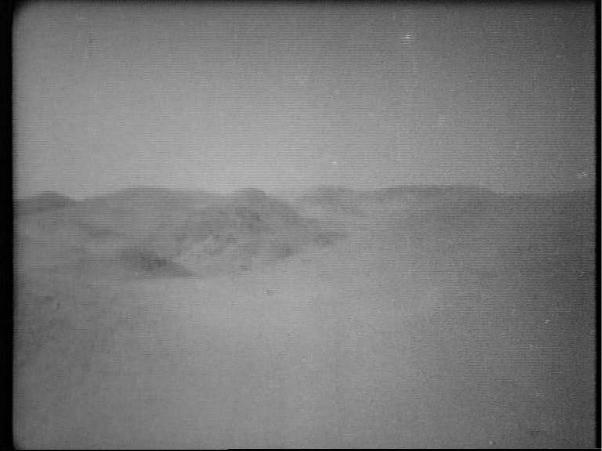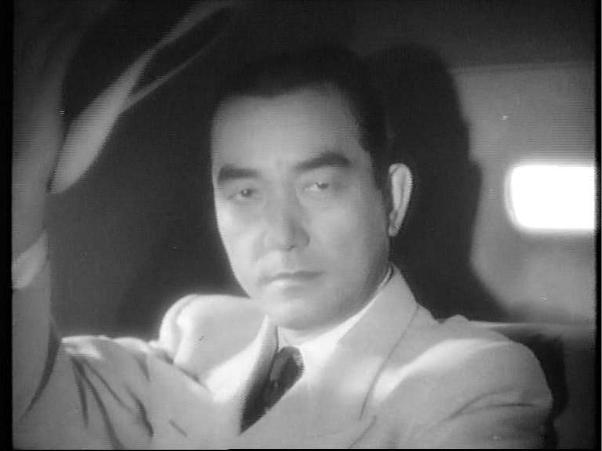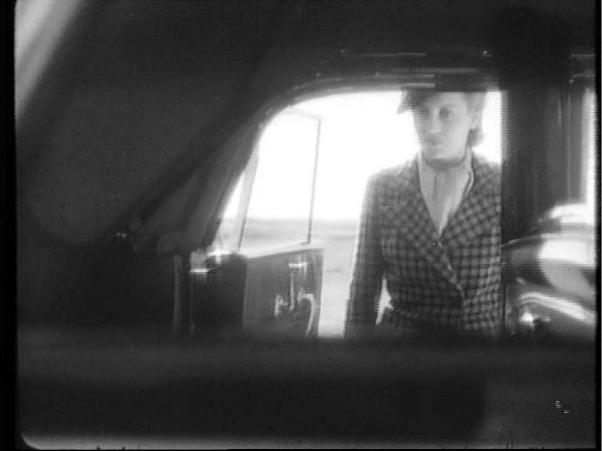
WilliamsT
.pdfHero and heroine sit together in a mock carriage as painted backdrops of European holiday destinations are scrolled past mechanically by a hardworking attendant. There, in one of the most obviously Brechtian passages in Ophuls' career, the fake backdrops instantly cast doubt on their declarations of undying love, hinting that those romantic hopes may be as false and insubstantial as the reproductions of landscape that pass behind them. The technique is duplicated exactly in Yoshiwara's imaginary sleigh ride, where a table and chair are metamorphosed by special effects into a sledge which carries Serge and Kohana along in front of a paint-and-cardboard St Petersburg.
Schüfftan's approach to lighting this scene functions to support the subversion of the couple's fantasy created by the art design of Léon and André Barsacq. Schüfftan maintains the same level of lighting as the scene shifts to and from fantasy and reality, rather than changing it, which would have the effect of, literally, transporting the spectator into the fantasy experienced by the couple. By maintaining the same lighting levels, Schüfftan fixes the action in reality, suggesting like the art design, that this can never become more than a mere fantasy.
As the film progresses however, and Ysamo's jealously increases, Schufftan's approach to lighting begins to change, becoming more stylised, reflecting the psychological trauma of the love triangle. This is in part because the weather of the latter scenes has descended into a storm, allowing Schufftan to use accent lights and key lights more in accordance with his usual style. We see this, for example, when Kohana and Serge share a moment together, knelt on the floor, and Schüfftan’s accent light is invested with erotic value as it picks out their hands, highlighting them as they briefly touch.
A good example of a dramatic use of lighting by Schüfftan, which makes full use of the storm, occurs when Ysamo spies on Kohana and Serge through the semi-transparency of the door, only moments after Serge has been wounded. We see Ysamo's face dramatically
121

illuminated from above, with shadows cast across it. His body stands in silhouette, positioned against the brightness of the fog. Schufftan chooses to create dramatic effects in the storm through light rather than darkness, allowing the set to be obfuscated through the fog and for the subjects to be viewed as sinister silhouettes.
Figure 29: Sessue Hayakawa in Yoshiwara.
The film provided Ophüls with his greatest prewar commercial success in France, due most likely to the film’s exotic Oriental setting, and the melodramatic elements of the plot (Bacher, 1996: 37). However, it was precisely these aspects of the film which failed to impress critics, as well as the Japanese government and its film industry, who roundly disapproved of the film's representation of their culture (Jacoby, 2002).
122
Schüfftan's next film was to be a significant one, if not for its quality, then because it was Schüfftan's first project under the direction of Marcel Carné, a director described by Dudley Andrew (1995: 175) as ‘poised to respond to the German cinema.’ Drôle de drame/Bizarre Bizarre (1937) is a comedy set in (a decidedly French vision of) London, which was shot alongside Schüfftan’s camera assistant Henri Alékan. According to Claire Blakeway (1990: 134), a lack of depth of field is a distracting effect of Carné’s mise-en-scène in this film, one which is at odds with the stylistic approach of Schüfftan that I have outlined thus far. She notes that, ‘Carné acknowledged the shallow appearance of these shots, remarking that the view of the street looked rather like a painted background, but then he also emphasized that he was not seeking to make a realistic film.’ (Ibid.) Blakeway also finds fault with Schüfftan’s lighting:
The two-dimensional impression was further exacerbated by the monotonous lighting effects, which evoked little variation in strength and contrast between the interiors and exteriors, often submerging character and setting in an unrelieved, crepuscular gloom. This said, however, the murky quality of the lighting (encouraged, no doubt, by Schüfftan’s involvement on Drôle de Drame) harmonised with the film’s black humour and the character’s obsession with murder.
(Ibid.)
The lighting effects of Drôle de drame described by Blakeway, are in fact quite removed from Schüfftan’s favoured stylistic approach. There is indeed a lack of contrast in the lighting of the film, arising from Schüfftan’s decision to employ little backlight, however, such stylistic traits are quite unusual in terms of his career. Whilst Blakeway sees this as a shortcoming of the film, Carné and Schüfftan create an impression through the flat lighting of the theatricality of this piece. The rather two-dimensional feel to the film which Blakeway has identified can therefore be seen as a consequence of the farcical theme, which necessarily required a fairly unrealistic mise-en-scène. Furthermore, Carné’s unique mise-en-scène,
123

alongside an emerging trend in French set design, no doubt required a different approach from Schüfftan. These issues shall be developed in greater detail with regard to Schüfftan and Carné’s subsequent collaboration, which was soon to come in 1938 with Le Quai des brumes.
Figure 30: Schüfftan's 'murky' lighting in Drôle de Drame.
Schüfftan's next feature of 1937, Forfaiture/The Cheat, saw him not only reprise his working relationship with Marcel L'Herbier, director of Le Scandale, but also with the actor Sessue Hayakawa, who had starred as Ysamo in Yoshiwara. As with Yoshiwara, Forfaiture drew its appeal from its exotic setting, this time a small Chinese town (with Hayakawa, a Japanese actor, embodying a generic Oriental 'otherness' adequate for Western audiences). The film was a remake of Cecil B. DeMille's The Cheat (1915), which had proven extremely popular
124

in France, inspiring its own opera, La Forfaiture, which opened in 1921, with lyrics by Paul Milliet and music by Camille Erlanger.16 However, it was clearly DeMille's original film which provided the inspiration for L'Herbier's interpretation, for Hayakawa's performance is actually a reprisal of the same role he had acted in 1915. As Jun Okada (2008: 368) rightly notes, ‘The remake was the result of a twenty-year dream harboured on the profound effect that The Cheat, and in particular, its star, had had on L’Herbier, and upon the burgeoning
French film culture in 1916, when it played to resounding success in the Paris boulevard cinemas.’17
The story is that of a young French woman, Denise Moret (Lise Delamare), who involves herself in charity work whilst her husband, Pierre (Victor Francen), works away. Denise soon finds herself in a gambling den where she loses all her money, leaving her with no other option but to accept an offer of money from Prince Hu-Long (Hayakawa), who has kept his eye on her since their first meeting. Denise changes her mind and decides not to keep the money. However, when she tries to return it to the Prince she discovers that she is now his property, a fact viscerally realised in the film when we see him brand Denise's flesh. In reaction Denise shoots and kills the Prince. However, it is Denise's husband Pierre who is arrested for the murder and who is put on trial. Just as the judge comes to find Pierre guilty, Denise confesses the true events to the court. Told by the judge that she has no proof, Denise dramatically pulls back her shirt to reveal the brand of Prince Hu-Long. Pierre is acquitted and has an emotional reconciliation with Denise at the close of the film.
16 This was in fact the first opera to be based upon a film (Miyao 2007: 25).
17Indeed, this was a particularly formative moment for L’Herbier, just prior to his induction into the film industry in 1917, in the form of the Section Cinématographique de l’Armée. Besides the reprisal by Hayakawa of his original role, L'Herbier goes even further to communicate in his remake the profound influence of DeMille's original text. At the very start of the film an on-screen title references The Cheat as the source material, and the credits which follow actually appear over footage of Hayakawa in his original role from 1915.
125

From the very start of the film Schüfftan fully emphasizes the exoticism of the location. In the opening scene, when Denise's car is attacked by bandits, Schüfftan creates a very bright image, possibly through use of over-exposure, or possibly by utilizing the natural light of the location. In fact, the brightness of the image is such that, in a shot where the camera looks out across the desert horizon, the sky and the sand begin to blend into one another (see Figure 31). This is a different effect to Die Herrin von Atlantis, where Schüfftan filmed in the desert at either dusk or dawn, in order to give some definition to the image. In Forfaiture, the spectator experiences the same sensation of blinding light as would be experienced by the characters in that situation.
Figure 31: In Fortaiture, Schufftan allows the horizon to blend into the sky, highlighting the brightness of the location.
126
When the car carrying Prince Hu-Long arrives, shown in the reflection of Denise’s car,
Schüfftan is able to contrast with the brightness of the location to great effect. The Prince is sitting in the back of the car, fully lit by Schüfftan from the left hand side of the frame, and is figured against a dark background with his shadow cast against it (see Figure 32). An air of mystery and enigma is created through this sudden shroud of darkness, aided of course by the exotic music, by Michel Michelet, over the soundtrack. The intrigue surrounding Prince HuLong is then emphasized by the reverse shot through the car of Denise who is doubly framed by both the car window and the doorway on the other side. This doorway forms a dark frame to the shot (see Figure 33). However, the light from the desert exterior forms a bright backlight to Denise. Such an effect, created by the brightness of the local sun, is further emphasised only a short time later, when the Prince returns Denise home. In this instance, there is a close-up shot of the symbol on the front of the Prince's car as he is driven away. The light catches this symbol, reflecting it into the lens of the camera as the car moves, creating a strong blinding effect. This adds to the sense of dread towards the Prince.
127

Figure 32: Sessue Hayakawa as the mysterious Prince Hu-Long in Forfaiture.
128

Figure 33: The reverse shot of Lise Delamere as Denise Moret.
The mise-en-scène is strongly lit throughout the film, with Schüfftan using a very strong backlight when lighting subjects in order to give definition to the image in the face of such bright natural light. Even when the action moves away from location shooting, the effect of the bright sun is recreated by Schüfftan through the use of strong key and sidelights, and a strong backlight is also used in interior scenes. This is quite opposed to the ‘murky’ flat images ascribed to Schüfftan in Drôle de drame. The number of exterior scenes featuring this bright lighting become far fewer once Denise has lost her money, allowing for the lighting to reflect the psychological situation she is in, so much so that when the style and mood of the film shifts in the second half (becoming a courtroom drama showing the murder trial of Pierre Moret), Schüfftan's lighting eschews the exoticism of the location presented in the first half of the film, grounding Denise in the consequences of her actions.
129
Following his work on Forfaiture, Schüfftan was reunited with Robert Siodmak, who had last worked with Schüfftan upon La Crise est finie. The film was Mollenard/Hatred (1937), which was produced by Productions Corniglion-Molinier who had previously produced Drôle de drame, and saw Henri Alékan reprise his role as Schüfftan's camera assistant. In the film Harry Baur plays the eponymous Mollenard, Captain aboard a ship engaged in illegal arms dealing at the port of Shanghai. The ship catches fire, forcing the Captain to retreat home with his crew to Dunkirk, where they are received with a hero's welcome. However, Mollenard experiences difficulties readjusting to his old family life, thanks to mutual contempt that has grown between him and his wife (Gabrielle Dorziat). This even leads to his daughter (Ludmilla Pitoëff) escaping the home and throwing herself into the dock, where Mollenard must save her. The Captain is eager to return to his life at sea, however, this desire is thwarted when he suffers a debilitating heart attack, leaving him under the charge of his despising wife. The denouement of the film sees Mollenard's crew carry him from his bed and take him aboard ship, allowing him to die in peace at sea.
In addition to the émigrés Schüfftan and Siodmak, Mollenard's crew also boasted the Hungarian set designer Alexandre Trauner, who had moved to France in 1929 to embark upon his career in film, and who had recently worked with Schüfftan on Drôle de drame. The film stands therefore as an example of émigré technicians who, with their own distinctive style, came to adapt to the demands of a foreign national cinema. We have already seen how Schüfftan, beginning with a strong sense of realism, began to incorporate aspects of an Expressionist style, in order to meet the expectations of his aesthetic outside of Germany. Siodmak similarly came to France intent on maintaining the realist aesthetic he had developed in Germany, proclaiming 'I hate operettas and vaudeville because they represent empty genres, sheer gaudy tinsel' (Andrew, 1995: 173). Nevertheless, through his time in France, Siodmak abandoned his earlier style of realism, adapting to the styles of the French
130
